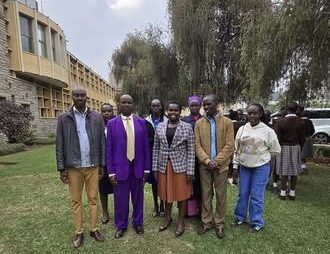I have read with apprehension Dr Mercy Igoki’s assertion that students go wrong with HELB loan applications by including too many details. That is a one-sided narrative. The issue can’t be the beneficiaries. On the flipside, HELB loans are frustrating. Shifting the burden of blame entirely onto students is not only unfair but also distracts from the deeper systemic problems within the Higher Education Loans Board (HELB) itself. Instead of scrutinising every pen stroke on the beneficiaries’ forms, we should be examining how the institution executes its mandate – and, unfortunately, this is where HELB goes terribly wrong.
Dr. Igoki’s suggestion that students derail their applications by giving too much information is a narrow framing. The real bottleneck is not the quantity of information, but the institution’s inability to process applications with efficiency and flexibility. Students provide extra details out of fear of being disqualified for incomplete forms — a fear that HELB’s own rigid, unforgiving systems have cultivated. The application process is often riddled with vague instructions, outdated requirements, and a lack of clear guidance, forcing students to guess what counts as “too much” or “too little” detail. If an application can be delayed or rejected because of minor formatting issues or excessive supporting evidence, the system is not student-friendly; it is broken.
There is aperennial disbursement delay crisis. One point rarely acknowledged in the “blame the student” narrative is the chronic delay in loan disbursements. HELB’s job is not simply to approve applications; it is to ensure timely financial support. Yet year after year, students report receiving their loans weeks or even months into the semester. By then, the damage is done: they have been sent home for unpaid fees, evicted from hostels, or missed critical classes. No amount of perfect form-filling can solve an institutional culture where timelines are flexible for the lender but inflexible for the borrower.
HELB emplots an opaque allocation formula. Dr. Igoki’s article sidesteps one of the biggest grievances – the lack of transparency in how loan amounts are determined. A student from a single-parent household living in rural poverty can be awarded less than a peer from a better-off background, with no clear explanation. Appeals are often ignored or met with template responses that do nothing to address the core concern: why do genuinely needy students sometimes get the smallest loans? Suggesting that “students go wrong” ignores the fact that HELB has never fully clarified the weighting of its allocation criteria. This opacity breeds suspicion, frustration, and inequity.
Communication failure and policy ambushes. It is misleading to imply that students fail because they don’t pay attention to instructions. The truth is, HELB’s communication is inconsistent, and sometimes, non-existent. Critical updates – from changes in repayment terms to alterations in loan amounts – are often buried in obscure website notices or dropped on social media without targeted alerts to affected beneficiaries. Many only learn of penalties, reduced allocations, or policy shifts after the fact. This is not a matter of failing to read fine print; it is a matter of an institution failing to communicate effectively.
READ ALSO:
The critical role of the church in mentoring youth during school holidays
HELB uses a punitive repayment trap. When beneficiaries graduate, the real struggle often begins. The penalties for late repayment are disproportionately harsh, quickly ballooning the debt to double or triple the original amount. Dr. Igoki’s focus on application errors entirely ignores this more destructive problem. Many graduates leave university into an economy where jobs are scarce and starting salaries barely cover living costs. HELB’s rigid penalty system makes no distinction between willful default and genuine financial hardship. If the aim is to recover funds and keep the scheme sustainable, strangling borrowers with penalties is counterproductive – it discourages compliance rather than encouraging it.
HELB employs aggressive recovery tactics over humane solutions. The Board’s collection methods – from threats of CRB blacklisting to employer shaming – have created a culture of fear rather than mutual responsibility. Salary deductions are executed with military precision, but hardship-based repayment plans are practically non-existent. If HELB showed as much innovation in supporting graduates as it does in pursuing them, the repayment problem would shrink significantly. Instead, the institution leans on intimidation rather than empathy.
The HELB Loan amount is out of touch with reality. Even for those whose applications go through without hiccups, the loan amounts often fail to match the real cost of living and studying in Kenya today. Tuition fees have risen sharply, as have rent, transport, and food costs. For some, the HELB disbursement barely covers tuition, forcing them to seek other loans or part-time work to survive. This shortfall is not because students applied wrongly; it is because HELB has failed to adjust its support to reflect inflation and the actual economic burden on students.
Well, Dr. Igoki tone confirms that the “customer” problem.
HELB’s attitude toward. Beneficiaries is still largely transactional and bureaucratic, treating them as files rather than human beings. The tone of communication, the inflexibility in processes, and the punitive default policies send a clear message: you are a debtor first, a student second. An institution created to uplift should be a partner in success, not a looming threat over a young graduate’s shoulder.
Instead of obsessing over whether students include “too much detail” in their applications, HELB should focus on making the application process clearer, reducing bureaucratic hurdles, and providing timely disbursements. Allocation formulas should be transparent, repayment terms should be flexible, and penalties should be proportionate. The Board could establish income-based repayment plans, offer grace periods in line with job market realities, and create partnerships that help graduates secure employment faster – ensuring repayment happens without resentment or hardship.
To blame the students is akin to turning the mirror inward. Dr. Igoki’s framing suggests that the solution lies in teaching students how to avoid application errors. That is part of the puzzle, but it is not the biggest piece. The more urgent task is institutional self-examination. Why does HELB disburse late? Why are allocation decisions so opaque? Why is communication so inconsistent? Why is repayment so punitive? Until HELB is willing to turn the mirror on itself, articles that lay the blame squarely at the feet of students will remain incomplete, if not outright misleading.
The HELB problem is not fundamentally about beneficiaries getting their forms wrong. It is about an institution whose processes are slow, opaque, inflexible, and at times, downright hostile to the very people it is meant to support. HELB should not be a debt collector with a side job in student funding; it should be a committed partner in building Kenya’s human capital. Until that shift happens, we will keep reading articles that point fingers at students while ignoring the far bigger failures within the system — and that, more than any application error, is what truly goes wrong with HELB.
By Ashford Kimani
Ashford teaches English and Literature in Gatundu North Sub County and serves as Dean of Studies.
You can also follow our social media pages on Twitter: Education News KE and Facebook: Education News Newspaper for timely updates.
>>> Click here to stay up-to-date with trending regional stories
>>> Click here to read more informed opinions on the country’s education landscape






